This QuickStart will guide you through the implementation of a quick and easy method for rapidly developing method to embed Sigma content in a Streamlit application. Embedding Sigma content within Streamlit applications is a powerful toolset that empowers developers, data analysts, and even business users to create interactive data applications backed by the power of Sigma.
What is Streamlit
Streamlit is an open-source app framework written in Python. It helps you create interactive web apps for data science and machine learning in a short time. It is compatible with all major Python libraries, such as scikit-learn, Keras, PyTorch, SymPy (LaTeX), NumPy, pandas, Matplotlib, and more.
Streamlit is intended to provide Snowflake users the ability to quickly deploy applications and share data.
Teams use Streamlit to build Python applications to benefit from:
- Rapid Development Cycle
- Simplified Coding Experience
- Flexible Components
- Internal or External Facing
- Extensible Embedding
Streamlit works seamlessly with Sigma to accelerate deployment for any data applications built, especially those that rely on visualizations, while providing the user with our industry-differentiated ability to deep dive into the data powering those visuals and unlocking the power of your data warehouse.
Building the analytics front-end in Sigma provides:
- A familiar, spreadsheet-like interface for end users.
- No-code or semantic knowledge required.
- Full role-based access control support.
- Data governance and lineage.
- Full feature set while embedded.
- The ability to leverage massive datasets.
For more information on Sigma's product release strategy, see Sigma product releases
If something is not working as you expect, here's how to contact Sigma support
Target Audience
The typical audience for this QuickStart includes users of Excel, common Business Intelligence or Reporting tools, and semi-technical users who want to try out or learn Sigma.
Prerequisites
- Any modern browser is acceptable.
- Access to your Sigma environment.
- Some familiarity with Sigma is assumed. Not all steps will be shown, as the basics are assumed to be understood.

We will start by setting up our local Python environment based on Miniconda, which is a lightweight version of Conda (Anaconda). If you already have an existing Python environment, you may use that, or proceed with Miniconda.
Conda is an open-source, cross-platform, language-agnostic package manager and environment management system. It was originally developed to solve complex package management challenges faced by Python data scientists, and today is a popular package manager for Python and R.
Miniconda is a much smaller installer (~200 MB vs. ~4+ GB) compared to full Conda and saves time and disk space compared with installing the full Conda application.
It includes only Conda, Python, the packages they depend on, and a small number of other useful packages, including pip, zlib and a few others.
Packages not included must be installed manually or called at runtime.
Use the following link to download the Miniconda Download the version that includes Python 3.8 or above based on your operating system and processor (e.g., x86 32-bit, 64-bit, or Apple Silicon).
After downloading the appropriate version of Miniconda for your operating system go ahead and run the installation, accept the license agreement and use the default settings:
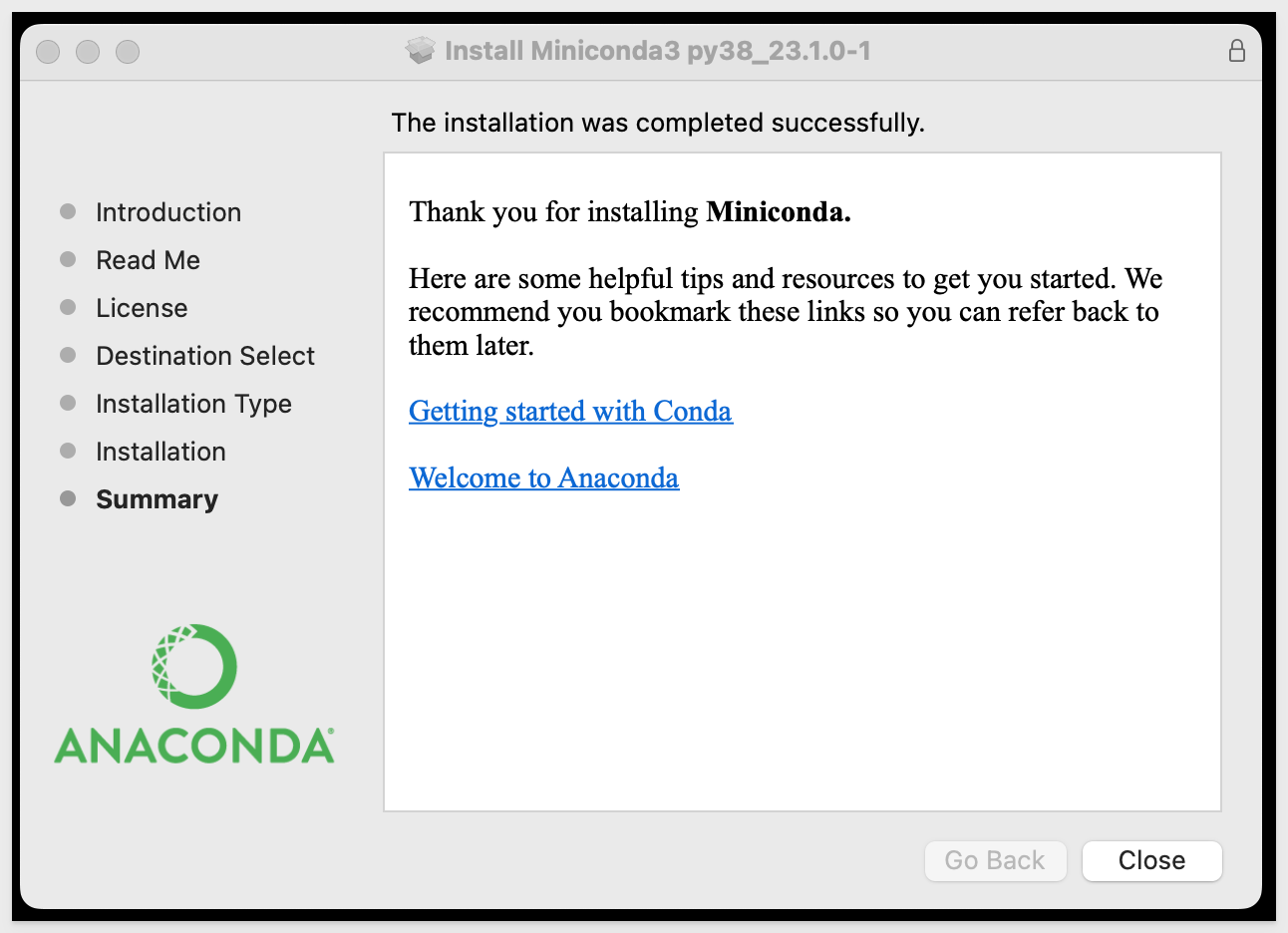
Now that Miniconda and Python (v3.8 or higher) are installed, we can move to the next step.

Install VSCode from Microsoft's download site
Run the installer and accept all default settings.
Once VSCode is installed, we'll configure it for this use case.
Open VSCode and click the sidebar icon for Extensions.
Search for Python, then select and install the extension shown below.

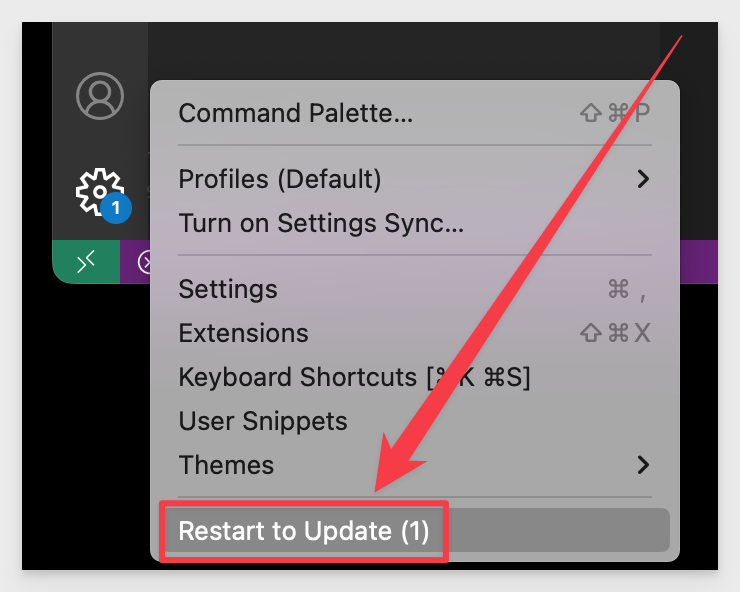
We now have a development environment ready, but we need to do a few more steps.

Since we installed Miniconda, every available Conda package is not present in our system. While this saves installation time and conserves disk space, it's important to remember, we will have to be aware that each VSCode project must have its required package dependencies installed at runtime.
While we could install packages globally, we prefer to avoid that to maintain tight control over our development environment.
To support this, we'll use dedicated Python environments to isolate project dependencies.
For our first project, we will create a Python environment called streamlit.
In our local computer, navigate to your Miniconda installation directory. The default is based on your computer username.
Right-click and open a terminal session:

First, let's see what environments already exist. Run the command:
conda env list
We should see the "base" environment that is included with Miniconda.

Now let's create a new environment called streamlit for our project. Run the command:
conda create --name streamlit python=3.8
When prompted to proceed, type y and hit return:
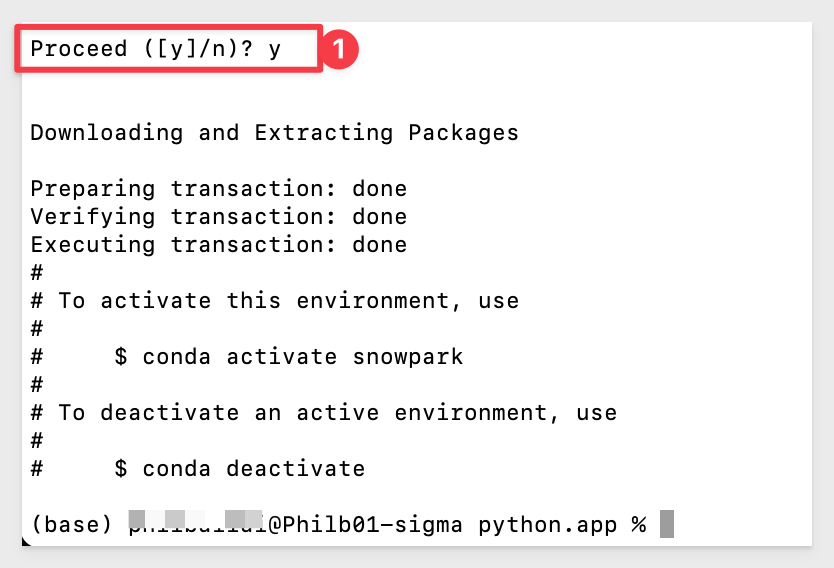
We need to activate our new environment. Run the command:
conda activate streamlit
Listing the environments again, we should see streamlit being the current select noted by the "*":
conda env list

Our new streamlit environment is now ready.

To install Streamlit locally. execute the following command in Terminal:
pip install streamlit
A lot of information will be displayed and the command prompt will appear when done. There should be no error messages:
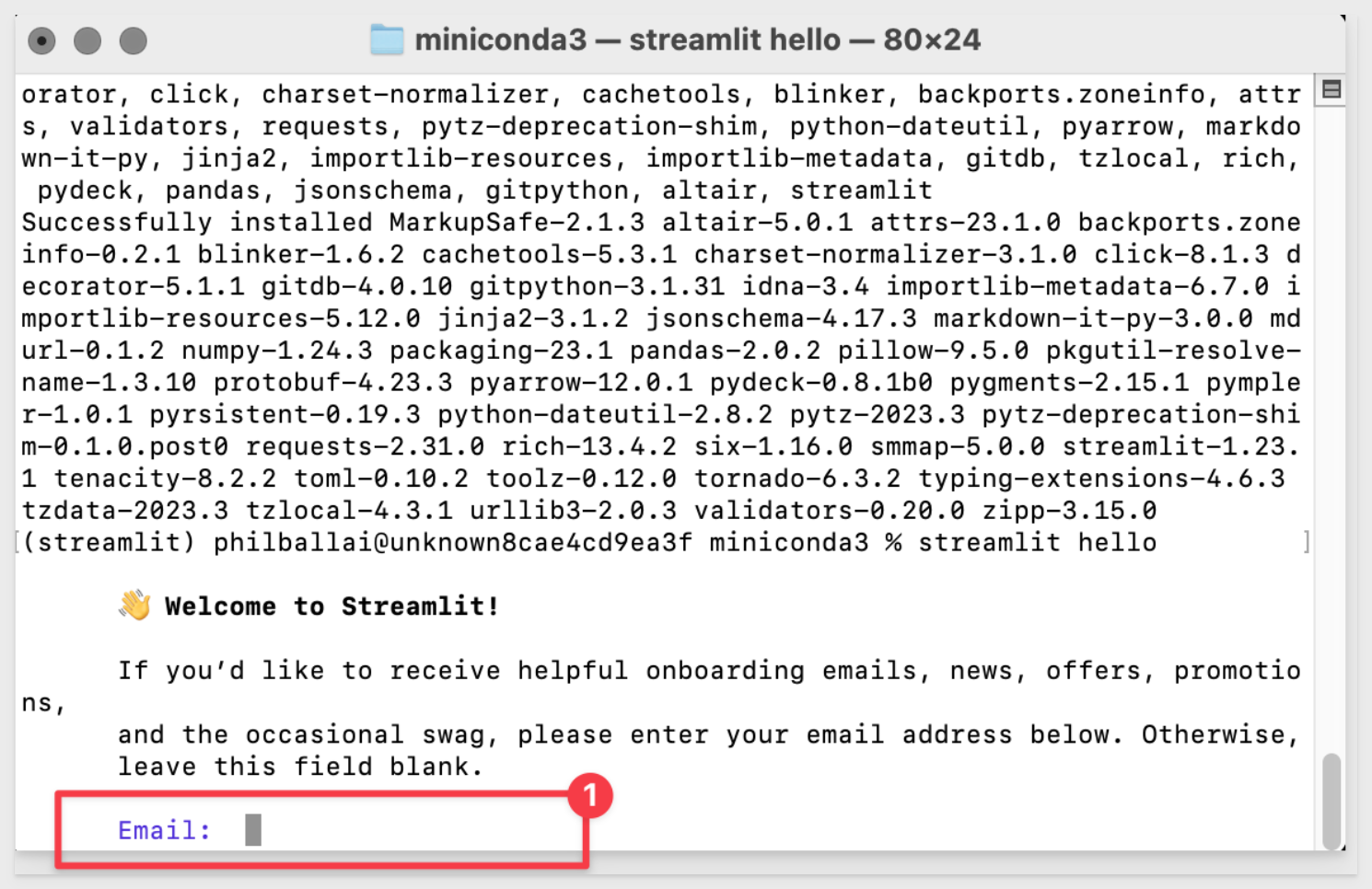
Now we can test our local Streamlit environment. Run the following command in your terminal:
streamlit hello
If prompted, click Allow to let Python accept incoming network connections:
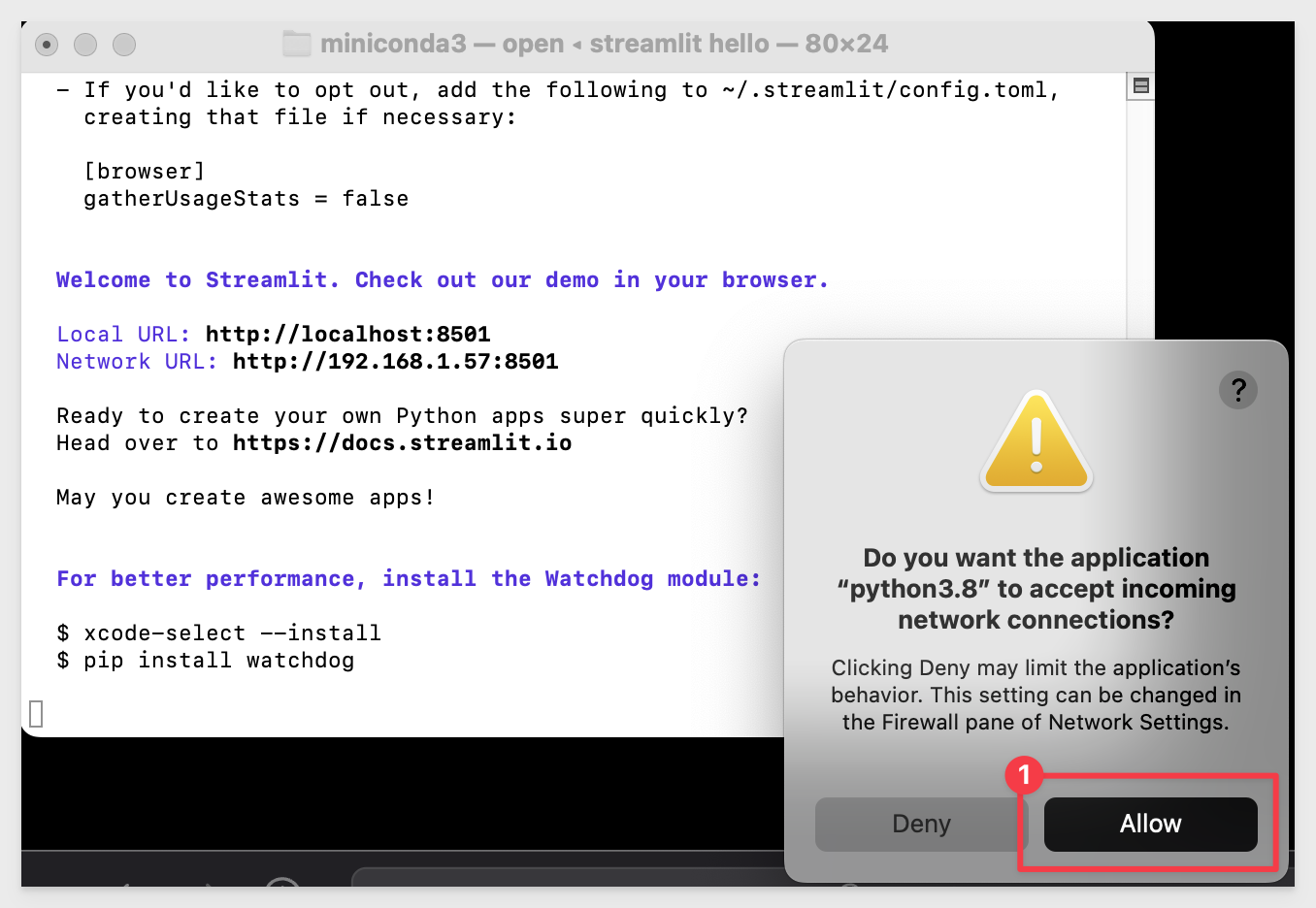
You may see a prompt asking for your email address (we will skip over that, so leave it blank and press Enter):

Streamlit will automatically open your default browser to its demo welcome page:


To make this easier, we've stored the project code in Git. While you could clone the entire repository (it's not that large), we want to avoid cloning sections of the repository that aren't relevant to this QuickStart.
Instead, we'll use VSCode and Terminal to perform a Git sparse-checkout of the specific project folder we're interested in. This involves a few extra steps but results in a cleaner local project folder.
Open VSCode and start a new Terminal session.
Navigate to the directory where you want to clone the repo folder:
For example:
cd {/path/to/your/directory}
Create a new directory for the project:
mkdir embedding_streamlit
Change to the new directory:
cd embedding_streamlit
Initialize a new Git repository:
git init
Add the remote repository as the origin:
git remote add -f origin https://github.com/sigmacomputing/quickstarts-public.git
Enable sparse checkout:
git config core.sparseCheckout true
Specify the folder to include in the sparse checkout:
echo "embedding_signed_URL/streamlit/" >> .git/info/sparse-checkout
At this point, we've run each command and haven't seen any errors:

Pull only the specified folder from the repository:
git pull origin main
You should now see a project folder called streamlit:

The project has almost everything we need, but we'll still need to configure some embedded content and credentials from Sigma before testing it out.

We need to embed something into Streamlit from Sigma. To keep this simple, we'll use the Plugs Electronics Profit Planning Tool Template.
Log into Sigma (as Administrator), navigate to Templates, and click the Plugs Profit Planning Tool Template:
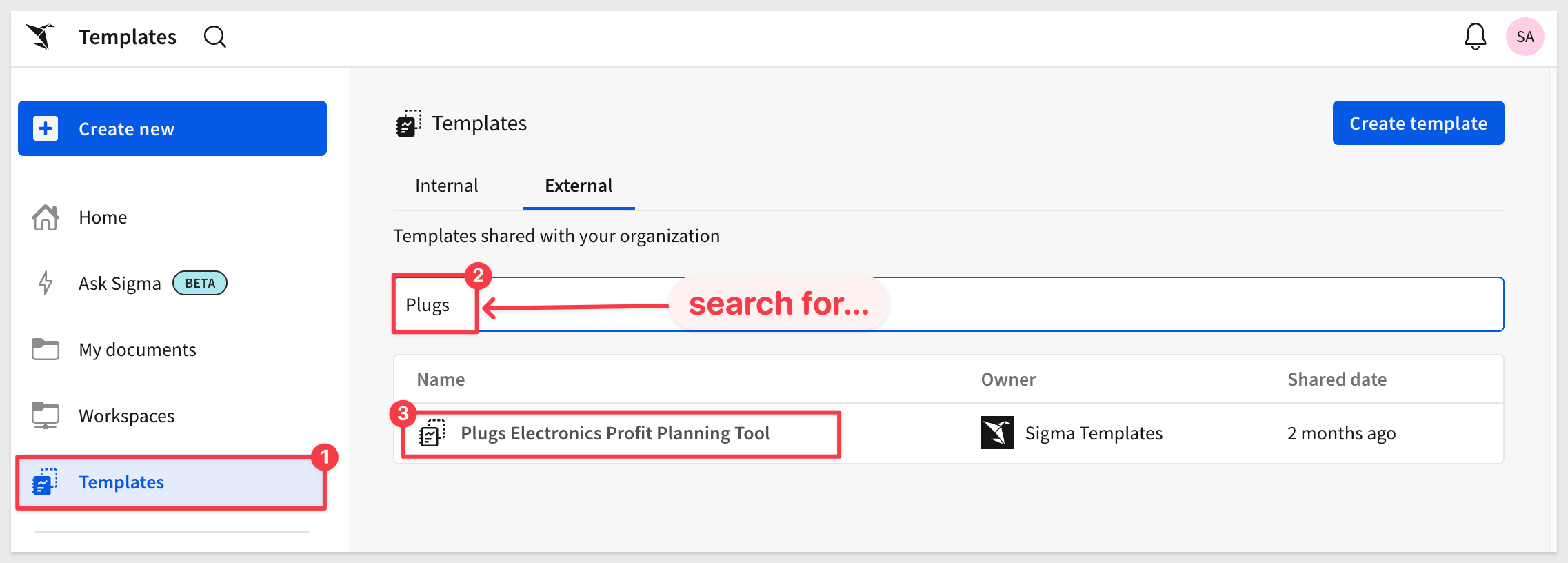
Next, we need the URL for the published version of the workbook:
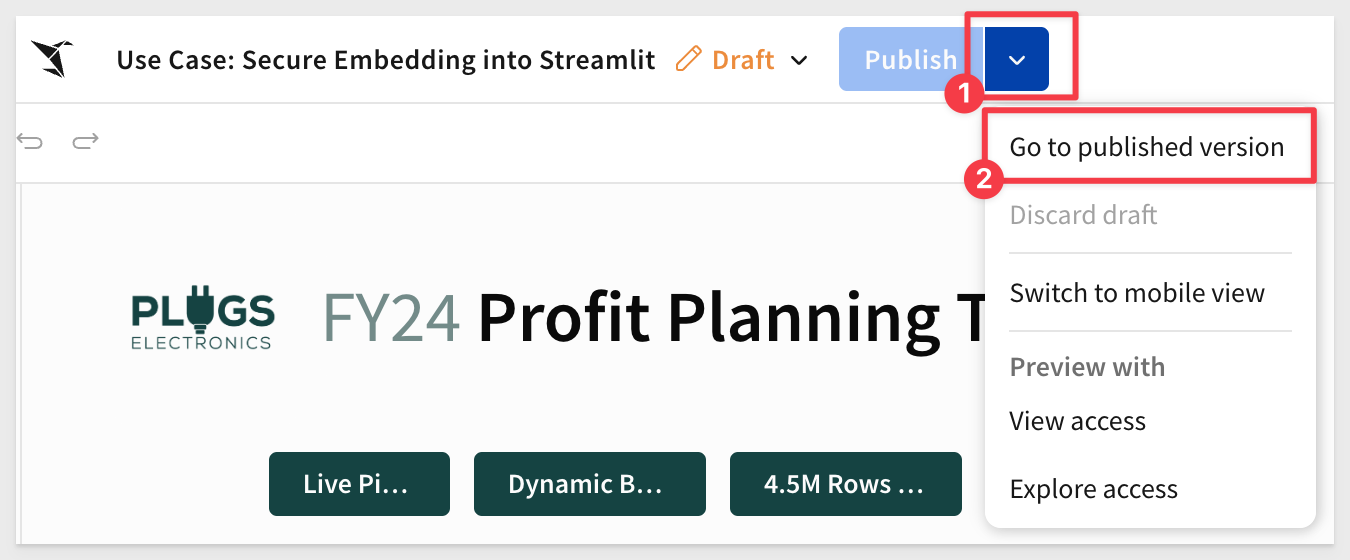
Once in the published view, copy the full URL from your browser and save it to a text file—you'll need it later.
Share with Team
We need to share our workbook with a Sigma team.
If you completed the Getting Started QuickStart for embedding, you should already have a team named Sales_People.
If not, go ahead and create it by navigating to Administration > Teams and click Create team:
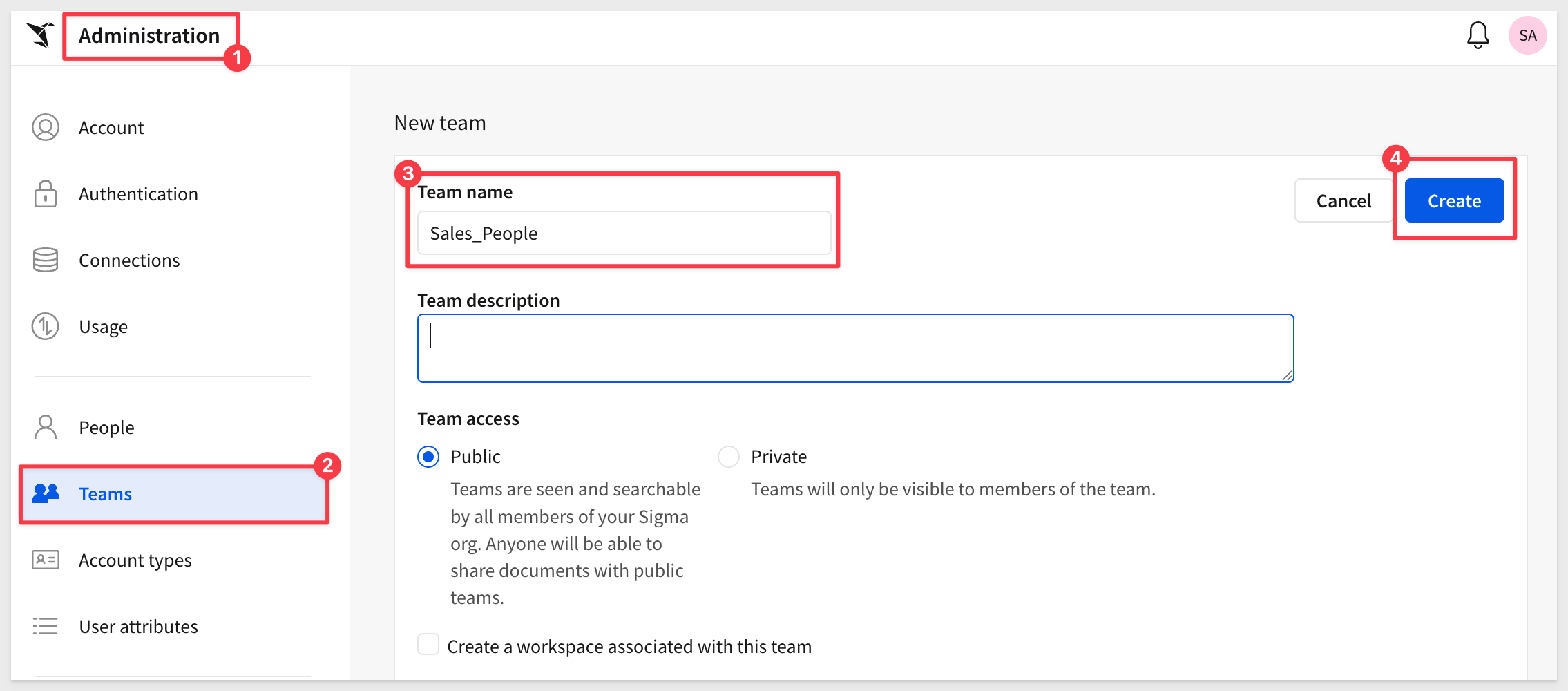
Sigma Embed Credentials
Now we'll generate credentials to secure the embed in Streamlit.
Navigate to Administration > Developer Access:

Click Create New in the top-right corner. This opens the Create client credentials modal.
Under Select privileges choose Embedding.
Provide a Name and Description of your choice.
Under Owner, select an organization member with the account type you want to associate with the embed secret. For now, select yourself or another Administrator.
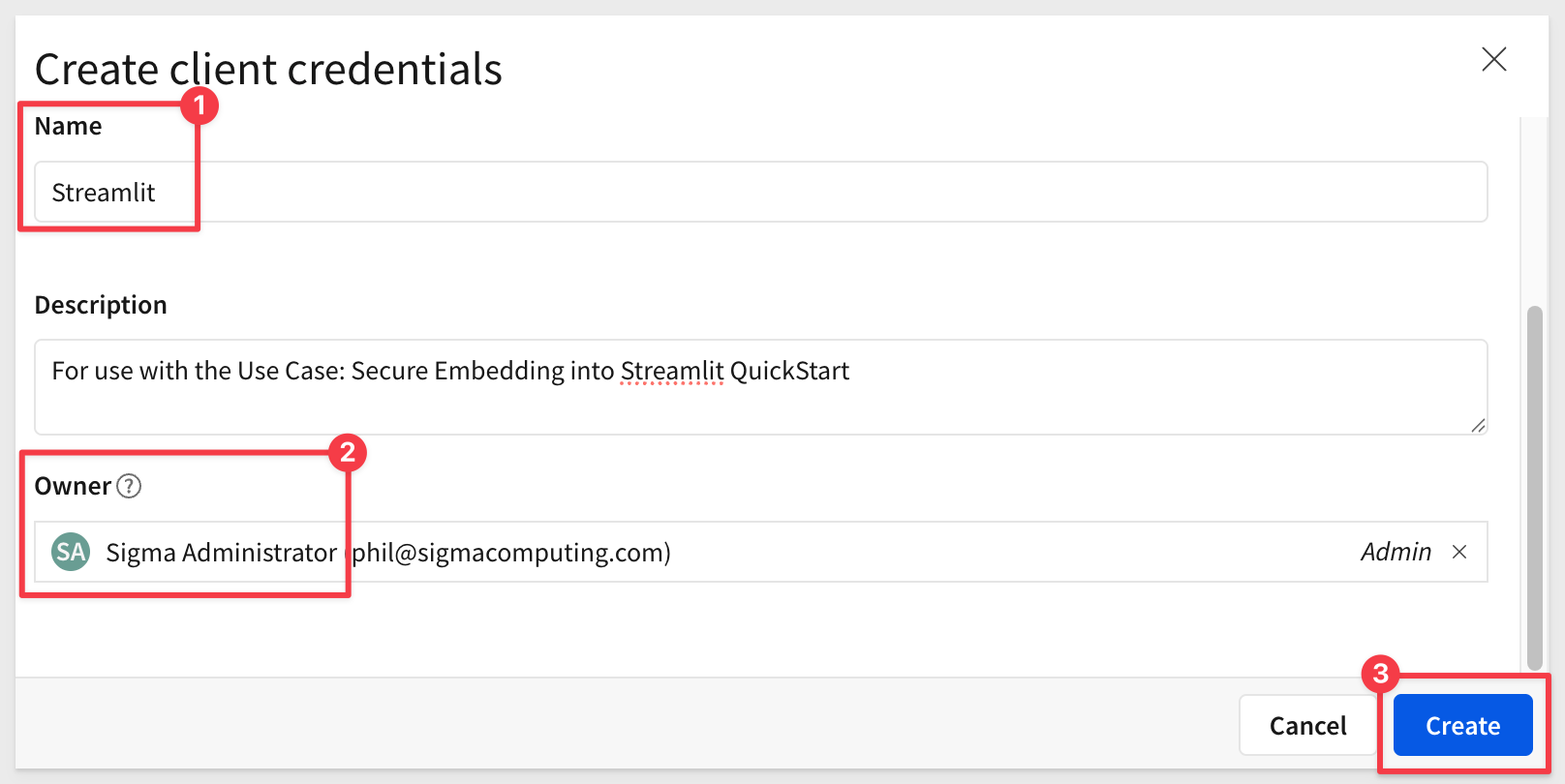
Click Create.
Copy the provided ClientID and Secret and store them for later use:

Click Close.
We can use these credentials for all embeds, but you may create as many credentials as you prefer.

Open the embedding_streamlit folder in VSCode and locate the .env file.
Replace the placeholder values with your own CLIENT_ID, SECRET and BASE_URL:
SESSION_LENGTH=3600
PORT=3000
CLIENT_ID=
SECRET=
BASE_URL=
EMAIL=sales_person@example.com
ACCOUNT_TYPE=Build
TEAMS=Sales_People
After updating .env with your values, save it.
Use a VSCode terminal session (or your terminal of choice) to navigate to your project folder and activate the Conda environment:
conda activate streamlit

Variables management
Our project stores configuration and sensitive values in a .env file, which helps keep secrets like API keys out of the main codebase—improving both security and flexibility.
To load values from the .env file, we use the python-dotenv package.
If you haven't already installed it, run this command in your terminal:
pip install python-dotenv
Start the Streamlit App
Once the environment is activated and dependencies are installed, launch the app:
Start the Streamlit app:
streamlit run app.py

Your browser should automatically open and display the Streamlit app with the embedded Sigma content:

Congratulations, you've successfully set up a Streamlit app with a secure Sigma embed.

In this QuickStart, we learned what Streamlit is and how to securely embed Sigma into a Streamlit application that we built together.
Additional Resource Links
Blog
Community
Help Center
QuickStarts
Be sure to check out all the latest developments at Sigma's First Friday Feature page!



